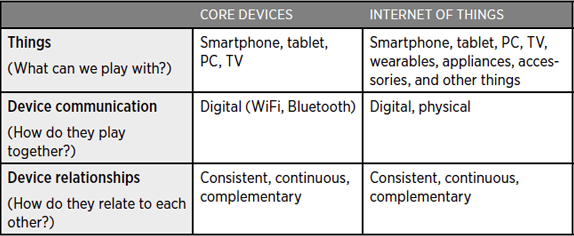Editor’s note: the following is an excerpt from our recently released book Designing Multi-Device Experiences, by Michal Levin.
In this excerpt, Levin addresses ecosystem experience design beyond the four core devices — smartphones, tablets, PCs, and TVs. She explores ways a consistent, continuous, and complementary (3Cs) design framework can be applied across the physical and digital spheres in our increasingly connected world.

Author Michal Levin, Senior User Experience Designer at Google.
We still need the oxygen flow provided by the wireless connection, transferring data between things across all experiences. But we can augment these digital connections with physical ones. Things can be physically attached or plugged into other things, and by doing so, we augment their capabilities in various ways.
In this new playground, an ecosystem experience doesn’t necessarily need to incorporate any of our core devices. However, as you will soon see, most of them still do — especially the smartphone, as it’s the one device that most people carry with them everywhere (see Table 6-1).

TABLE 6-1. Comparison between ecosystem experiences based on core devices versus Internet of Things.
Table 6-1 will guide us through the variety of examples in this chapter, where we will see how multi-device experiences can be approached in very diverse ways in a connected world. These examples are ones I find compelling in terms of creativity, innovation, design thinking, and value offering — and they carry broader design insights from which we can learn.
For each example, I will introduce the product objectives, describe the ecosystem experience design, and then discuss the main design takeaways.
Adaptive design: Nest — the learning thermostat

Nest — The Learning Thermostat. The display is normally black, but changes to blue when the thermostat is cooling, and orange when heating.
Users can also control the Nest thermostat remotely with any of the core devices (smartphone, tablet, or PC): turn it on or off, change the temperature, and access other settings. In addition, Nest provides a detailed energy usage history (data it collects anyway as part of the learning process), so people can stay informed and in control of their use patterns.
As you’ve probably noticed, Nest combines the following two approaches in its design:
- Complementary design, which establishes the connection between the thermostat and the smartphone, tablet, or computer so people can control it remotely.
- Consistent design, which is incorporated through Nest’s having three devices — PC, tablet, and smartphone — that offer the same experience design, serving as substitute devices. These devices enable people to engage in the complementary flow in a variety of contexts, at home as well as on the go.
Design lesson: The control relationship between devices is not bound to the TV
Up until now, we’ve discussed only TV-based ecosystems that utilize a control relationship between devices. Adding Nest to the mix highlights the idea that essentially any product that is already operated by remote control (or can benefit from having one) is a promising candidate for a complementary ecosystem. Just replace the traditional remote control with a smart device (mainly the smartphone), build an app for that, and — ta-da! — a new ecosystem is born. The Phillips smart lighting product HUE — “personal, wireless lighting” — is another example of a non-television ecosystem, in which users manipulate the intensity and color of the lighting in their environment (and what time the lights go on) from a phone or tablet once they’ve installed the lighting in their homes and the app on their handheld devices.
Design lesson: Extracting (actionable) knowledge from data
Nest is an example of a product that relies on adaptive design, in which a system “gets to know” its users over time — collecting and analyzing data about users’ behavior patterns, preferences, actions, and contexts of use. Then, based on the intelligence extracted, it can adapt itself accordingly, tailoring the experience and refining it continuously to fit a specific user’s needs across contexts. This context awareness, along with progressive learning, is a key part of the IoT vision; this approach reflects an important leap from merely collecting raw data across devices to extracting useful information out of it, so that the system can act upon it and empower people to perform better on life’s stage.
While the next chapter will discuss data collection and analysis in a multi-device world, which is an important challenge on its own, it’s important to remember that data is just a means to the goal. The Holy Grail lies in making that data actionable for people, preferably in an intelligent and seamless way, so that it actively helps them achieve their goals. Nest is a good example of a product experience that goes that extra mile — from just informing users with its data, to using that data behind the scenes to fuel the product behavior in an adaptive, contextual manner.


